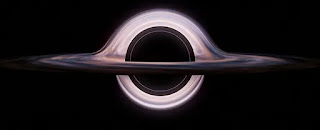1st Edition of International Young Scientist Awards
Wormholes May Already Have Been
Detected, Physicists Say
Thankfully however, if a new model proposed by a small team of physicists from Sofia University in Bulgaria is accurate, there could still be a way to tell them apart.
Play around with Einstein's general theory of relativity long enough, it's possible to show how the spacetime background of the Universe can form not only deep gravitational pits where nothing escapes – it can form impossible mountain peaks which can't be climbed.
Unlike their dark cousins, these glowing hills would shun anything that drew near, potentially belching out streams of particles and radiation that had no hope of ever turning back.
Setting aside the distinct possibility the Big Bang looks just like one of these 'white holes', nothing of it's like has ever been observed. Nonetheless, they remain an interesting concept for exploring the edges of one of the greatest theories in physics.
In the 1930s, a colleague of Einstein's named Nathan Rosen showed there was nothing to say the deeply curved spacetime of a black hole couldn't connect to the steep peaks of a white hole to form some kind of bridge.
In this corner of physics, our everyday expectations on distance and time go out the window, meaning such a theoretical link could traverse vast stretches of the cosmos.
Under the right circumstances, it might even be possible for matter to ride this cosmic tube and come out the other end with its information more or less intact.
So to determine what this black hole with a butthole might look like to observatories like the Event Horizon Telescope, the Sofia University team developed a simplified model of a wormhole's 'throat' as a magnetized ring of fluid, and made various assumptions on how matter would circle it prior to being swallowed.
Particles caught up in this furious maelstrom would produce powerful electromagnetic fields that would roll and snap in predictable patterns, polarizing any light emitted by the heated material with a clear signature. It was the tracing of polarized radio waves that gave us the first stunning images of M87* in 2019, and Sagittarius A* earlier this year.
A typical wormhole's smoking hot lips, it turns out, would be hard to distinguish from the polarized light emitted by the swirling disc of chaos surrounding a black hole.
By that logic, M87* could very well be a wormhole. In fact, wormholes could be lurking at the end of black holes everywhere, and we would have no easy way of knowing.
That's not to say there's no way of knowing at all.
If we were to strike it lucky and stitch together an image of a candidate wormhole as seen indirectly through a decent gravitational lens, subtle properties that distinguish wormholes from black holes just might become apparent.
This would require a conveniently placed mass in between us and the wormhole to distort its light sufficiently to magnify the small differences, of course, but it would at least give us a means of confidently spotting which dark patches of emptiness have a back exit.
There is one other means, one that also requires a good dose of fortune. Were we to spot a wormhole at the perfect angle, light traveling across its gaping entrance towards us would have its signature enhanced even further, giving us a clearer indication of a gateway through the stars and beyond.
Further modeling could reveal other characteristics of light waves that help sift wormholes out of the night sky without the need of lensing or perfect angles, a possibility the researchers are now turning their attention to.
Putting further constraints on the physics of wormholes could reveal new avenues for exploring not just general relativity, but the physics that describes the behavior of waves and particles.
Beyond that, lessons learned from predictions such as these could reveal where general relativity breaks down, opening a few holes of its own to make bold new discoveries that could give us a whole new way of seeing the cosmos.
International Young Scientist Awards Organised by Sciencefather youngscientistawards.com #youngscientist #sciencerocks #physicist #scientist #laboratory #biologist #science #microbiology #biotech #biochemistry #technology #study #universe #medicalstudent #research
International Young Scientist Awards
website link: https://youngscientistawards.com/awards/
Submit your Abstract below nomination link:
Nomination Link : https://x-i.me/suwyou5
Registration Link : https://x-i.me/youreg15




Comments
Post a Comment